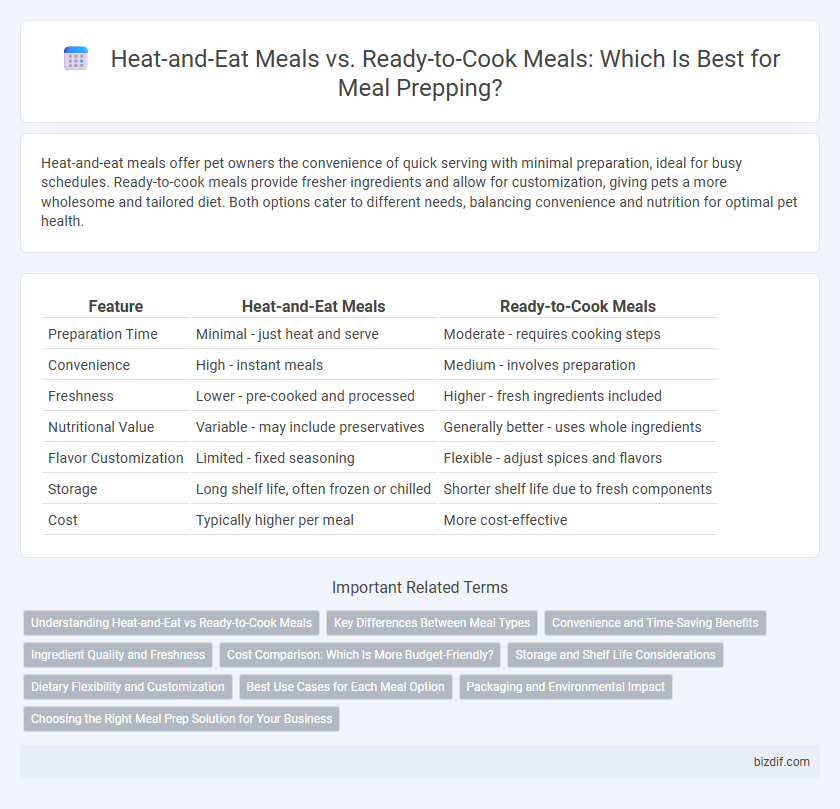Heat-and-eat meals offer pet owners the convenience of quick serving with minimal preparation, ideal for busy schedules. Ready-to-cook meals provide fresher ingredients and allow for customization, giving pets a more wholesome and tailored diet. Both options cater to different needs, balancing convenience and nutrition for optimal pet health.
Table of Comparison
| Feature | Heat-and-Eat Meals | Ready-to-Cook Meals |
|---|---|---|
| Preparation Time | Minimal - just heat and serve | Moderate - requires cooking steps |
| Convenience | High - instant meals | Medium - involves preparation |
| Freshness | Lower - pre-cooked and processed | Higher - fresh ingredients included |
| Nutritional Value | Variable - may include preservatives | Generally better - uses whole ingredients |
| Flavor Customization | Limited - fixed seasoning | Flexible - adjust spices and flavors |
| Storage | Long shelf life, often frozen or chilled | Shorter shelf life due to fresh components |
| Cost | Typically higher per meal | More cost-effective |
Understanding Heat-and-Eat vs Ready-to-Cook Meals
Heat-and-eat meals offer convenience with pre-cooked ingredients that only require reheating, making them ideal for quick consumption. Ready-to-cook meals provide pre-measured ingredients that need cooking, allowing for fresher taste and customization. Consumers choose based on priorities such as time-saving or culinary control in meal prepping.
Key Differences Between Meal Types
Heat-and-eat meals offer convenience by requiring only reheating, making them ideal for quick consumption with minimal preparation. Ready-to-cook meals include raw or partially prepared ingredients, allowing for customization and fresher tastes but demanding more time and cooking skills. The primary difference lies in preparation time and culinary control, with heat-and-eat meals prioritizing speed and ready-to-cook meals emphasizing cooking experience and ingredient freshness.
Convenience and Time-Saving Benefits
Heat-and-eat meals offer unmatched convenience by requiring minimal preparation, making them ideal for busy individuals aiming to save time during hectic schedules. Ready-to-cook meals, while requiring some preparation, still significantly reduce meal prep time by providing pre-measured ingredients and step-by-step instructions. Both options streamline the cooking process, allowing consumers to enjoy home-cooked flavors without extensive effort or time commitment.
Ingredient Quality and Freshness
Heat-and-eat meals often use preservatives and pre-cooked ingredients, which can compromise ingredient quality and limit freshness compared to ready-to-cook meals. Ready-to-cook meals typically feature raw or minimally processed components, preserving natural flavors and nutritional value through fresher ingredients. Consumers prioritizing high ingredient quality and freshness tend to prefer ready-to-cook options for a more wholesome and flavorful meal prep experience.
Cost Comparison: Which Is More Budget-Friendly?
Heat-and-eat meals generally cost more per serving due to convenience factors, while ready-to-cook meals often provide more ingredients and larger portions at a lower price point. Ready-to-cook options allow shoppers to buy in bulk and utilize pantry staples, reducing overall cost and food waste. Meal prepping with ready-to-cook meals maximizes budget efficiency without sacrificing nutritional value or variety.
Storage and Shelf Life Considerations
Heat-and-eat meals offer convenience with shorter storage times, typically lasting 3 to 7 days refrigerated due to their fully cooked nature. Ready-to-cook meals usually contain raw ingredients that require freezing or refrigeration, extending shelf life up to several weeks but demanding careful temperature control. Proper packaging and storage conditions critically impact the freshness and safety of both meal types, influencing nutrient retention and microbial growth.
Dietary Flexibility and Customization
Heat-and-eat meals offer limited dietary flexibility due to pre-cooked ingredients and fixed portion sizes, restricting customization options for specific nutritional needs or flavor preferences. Ready-to-cook meals provide greater adaptability by allowing control over cooking times, ingredient additions, and seasoning adjustments, facilitating tailored macro- and micronutrient intake. This customization enhances dietary adherence for various eating plans, including ketogenic, paleo, or vegetarian diets, promoting better long-term nutritional outcomes.
Best Use Cases for Each Meal Option
Heat-and-eat meals are ideal for quick, convenient consumption during busy weekdays or for individuals lacking kitchen access, as they require minimal preparation and cooking time. Ready-to-cook meals work best for those seeking fresher flavors and customizable cooking experiences, allowing control over ingredients, seasoning, and cooking methods. Meal prepping efficiency increases by matching heat-and-eat options with time constraints and ready-to-cook meals with planned cooking sessions that optimize taste and nutrition.
Packaging and Environmental Impact
Heat-and-eat meals typically come in single-use plastic containers that contribute significantly to landfill waste, whereas ready-to-cook meals often use recyclable or biodegradable packaging materials. Sustainable meal prep brands are increasingly adopting eco-friendly packaging solutions like compostable films and cardboard to reduce environmental impact. Consumers prioritizing greener options should consider packaging lifecycle, carbon footprint, and recyclability when choosing between heat-and-eat and ready-to-cook meals.
Choosing the Right Meal Prep Solution for Your Business
Heat-and-eat meals offer convenience and speed, making them ideal for businesses targeting busy consumers who prioritize quick access to prepared food. Ready-to-cook meals cater to customers who value freshness and customization, allowing control over the cooking process while maintaining quality ingredients. Evaluating your target market's preferences, supply chain capabilities, and storage requirements helps determine whether heat-and-eat or ready-to-cook solutions align best with your business model and operational goals.
Heat-and-eat meals vs ready-to-cook meals Infographic

 bizdif.com
bizdif.com